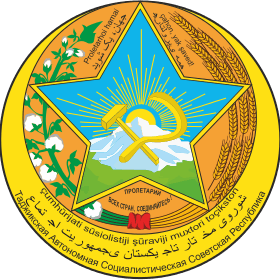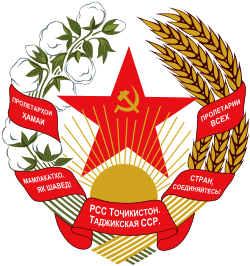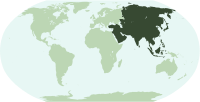Emblem of Tajikistan
| Emblem of Tajikistan | |
|---|---|
 | |
| Details | |
| Armiger | Republic of Tajikistan |
| Adopted | 1993 |
| Supporters | Cotton and Wheat surrounded by banners of the national flag |
The State Emblem of Tajikistan is a modified version of the original emblem of the Tajik Soviet Socialist Republic that was in use until the dissolution of the Soviet Union in 1991.
History
Prior to the Russian Revolution, the territory of Turkestan, of which Tajikistan was part, used the device of a black unicorn on a golden shield, blazoned or, a unicorn passant sable. However, Tajikistan itself had no symbol.
Until 1992, Tajikistan had a emblem similar to all other Soviet Republics.[1]
The first emblem of independent Tajikistan from 1992-1993 was the Lion and Sun symbol, which was a historic symbol of Persia, to which Tajikistan has cultural ties. It was changed to the current version by the government of Emomalii Rahmon, which came to power at the end of 1992. Like other post-Soviet republics whose symbols do not predate the October Revolution, the current emblem retains some components of the Soviet one.
Description
The crown at the center of the emblem is the same as the Tajik national flag, and refers to the Persian word taj, meaning crown, from which the name of the Tajik people is said to be derived, according to one interpretation. The base of the emblem contains a representation of a book and the Pamir Mountains. The emblem is flanked by cotton on one side and wheat on the other, as well a banner of the national red-white-green colors of Tajikistan is wrapped around the cotton and wheat replacing the red color with the motto of the Soviet Union "Workers of the world, unite!" written in the Russian and Tajik languages.
 First Emblem of Tajikistan on a 1994 postage stamp
First Emblem of Tajikistan on a 1994 postage stamp Mural of the Tajik coat of arms in Dushanbe
Mural of the Tajik coat of arms in Dushanbe Coat of arms of Tajikistan 1992-1993
Coat of arms of Tajikistan 1992-1993
Coat of arms of Tajik ASSR

In accordance with the decree of the Presidium of the CEC of the Tajik ASSR, dated 23 February 1929
State coat of arms of Tajik ASSR consisted of gold dosa (Tajik hammer) and hammer placed crosswise arms downward and located in the Golden rays of the sun, surrounded by a wreath of wheat ears on the right and a branch of cotton with opened bolls on the left on an orange background. Below the inscription in Russian: "Proletarians of all countries, unite!". Above the inscription in Tajik language on the Persian letter "Proletarians of all countries, unite!"

In accordance with article 105 of the Constitution of the Tajik ASSR 1929,
The national emblem of the Tajik Soviet socialist Republic consisted of a dosa (similar to hammer) and hammer in gold laid crosswise arms downward and located on a five-pointed star in the blue sky lit by the Golden rays of the Golden sun rising from behind snow-covered mountains. The star is surrounded by a crown of wheat ears on the right and a branch of cotton with open bolls left on orange background. At the bottom of the wreath ribbon red (scarlet) color. Under the star is the inscription in Russian: "Proletarians of all countries, unite!". On top of the star an inscription in Tajik Persian the Tajik Latin letter: "Proletarians of all countries, unite!". The internal image of the coat of arms surrounded by a gold ribbon in the form of a Crescent, horns up. Three inscriptions are arranged one above the other on the tape: the letter in Persian, Tajik A. S. S. R. and the letter in Russian: "the Tajik Autonomous Soviet socialist Republic". All these three inscriptions are arranged in a semicircle on a gold ribbon in the shape of a Crescent.
Coat of arms of the Tajik SSR
According to the Constitution of the Tajik SSR, adopted on 24 February 1931 4th Congress of Soviets of the Tajik SSR
.svg.png)
The coat of arms consisted of an image of a five-pointed star, the top of which were placed the hammer and sickle in the rays of the sun, and in the lower part: a factory building near the mountain slopes, a railway bridge, a flock of sheep, a tractor, a locomotive. Star framed by a wreath of ears of wheat (right), twigs of cotton (left) and grapes (bottom), a wreath was intertwined by ribbon with the motto "Proletarians of all countries, unite!" In the lower sector of the circle were placed the words "Tajik SSR" in Tajik Latin, starohradska and Russian languages.
According to the Constitution, adopted SetEditSem V Congress of Soviets in January 1935, coat of arms remained unchanged, only the name of the Republic became to be abbreviated as "the Tajik SSR". On June 27, 1935, the Presidium of the CEC of the Tajik SSR invited the artist Alexander Yakovlev S. to Refine your project of the emblem (project A. S. Yakovlev took 1st place in the competition, 1934).
July 4, 1935, draft, revised, too, was approved by the Presidium of the CEC of the Tajik SSR
April 27, 1936, approved by the Decree of the CEC of the Tajik SSR
.svg.png)
A wreath of wheat ears on the right and twigs of cotton c cotton bolls on the left bottom in the place of the intertwining branches of cotton and ears of corn were placed hammer and sickle surrounded by brush and vine leaves; in the middle of the sickle - silk cocoons; the wreath is intertwined with red ribbon with the motto "Proletarians of all countries, unite!" in Tajik (left) and Russian (right); inside the wreath from the bottom up were the tractor, two sheep, arable land, canal, building hydro power stations with a red flag on it, trees, village, neftevyshka, mountains; over the mountains the sun rises, the rays of which is placed the inscription "Tajik SSR" in the Tajik language; between the ends of the wreath - red five-pointed star.
April 27, 1936, the Presidium of the CEC of the Tajik SSR adopted the resolution "On approval of the description of the State emblem of the Tajik Soviet socialist Republic".
May 26, 1936 fourth session of the CEC of the Tajik SSR of the fifth convocation adopted the images and descriptions of the coat of arms and flag and made these descriptions in article 92 and 93 of the Constitution of the Tajik SSR.
According to the Constitution, adopted SetEditSem VI Extraordinary Congress of Soviets on March 1, 1937, the emblem has been greatly simplified: in the centre of the coat of arms in the Golden rays of the sun depicted a red five-pointed star, the top of which were placed the Golden hammer and sickle. All framed by a garland of ears of wheat (right) and branches of cotton with opened bolls (left). Wreath twined the red ribbon with inscriptions in Tajik and Russian languages: "Proletarians of all countries, unite!" and "Tajik SSR"(at the base of the wreath).
On the basis of the constitutional descriptions of the preparation of the images of the emblem and flag. May 19, 1937 the Presidium of the CEC of the Tajik SSR has considered the figures of the coat of arms and flag of the Republic and recommended to do the motto on the coat of arms of gold, to make the background of the emblem and leaves of cotton light green, hammer and sickle on the star to represent gold.
May 20, 1937, the Presidium of the CEC of the Tajik SSR had reviewed the draft drawings of the coat of arms and flag, adopted a decree "About the State emblem and flag of the Tajik SSR". This resolution was finally approved only flag and coat of arms recommended change: the Motto "Proletarians of all countries, unite!" was recommended to write in gold, the background and the leaves of cotton to pale green, the sickle and the hammer of gold, the rays of the sun to place on the circumference. On May 23, 1937, the Presidium of the CEC approved the coat of arms. According to established in 1937 as a Commission under the Presidium of the Supreme Soviet of the translation of the motto "Proletarians of all countries, unite!" in Tajik language was made inaccurately:
In 1938 the abbreviation on the flag and emblem of the "Ç" from the word "Çumhurijat" was replaced by the letter "R" from the word "Respublika". Resulting in the inscription on the emblem took the form of "RSS Tocikiston". A complex overburdened coat of arms did not satisfy many, the CEC of the Tajik SSR in 1934 even held all-Union competition for the development of new characters, from the residents of the USSR were received 106 projects the national emblem of the Tajik Soviet Socialist Republic consists of the image of a five-pointed star, the top of which depicts a hammer and sickle in the rays of the sun. Five-pointed star framed by a wreath composed on the right from ears of wheat, on the left from branches of cotton with opened bolls. From above a wreath is a ribbon with the inscription: "Proletarians of all countries, unite!" in Tajik and Russian languages. In the lower sector of the circle formed by the crown, the ribbon with the inscription "Tajik SSR" in Tajik and Russian languages.

On September 28, 1940, the Presidium of the Supreme Soviet of the Tajik SSR issued a decree
who changed the spelling of the texts of the inscriptions on the flag and coat of arms with the Latin alphabet new alphabet based on the Russian alphabet In the new Constitution of the Tajik SSR (1978) description of the coat of arms has not changed. The official description of the coat of arms in the text of the Constitution:
"Article 131. The national emblem of the Tajik Soviet Socialist Republic consists of the image of a five-pointed star, the top of which depicts a hammer and sickle in the rays of the sun. Five-pointed star framed by a wreath composed on the right from ears of wheat, left Yves branches of cotton with opened bolls. From above a wreath is a ribbon with the inscription: "Proletarians of all countries, unite!" in Tajik and Russian languages. In the lower sector of the circle formed by the crown, the ribbon with the inscription "Tajik SSR" in Tajik and Russian languages".
See also
References
- ↑ Borjian, Habib (December 15, 1999). "FLAGS iii. of Tajikistan". Encyclopædia Iranica. Archived from the original on February 4, 2013. Retrieved February 4, 2013.
External links
| Wikimedia Commons has media related to Coats of arms of Tajikistan. |
- Heraldicum.ru — Emblems of Tajikistan (Russian)
